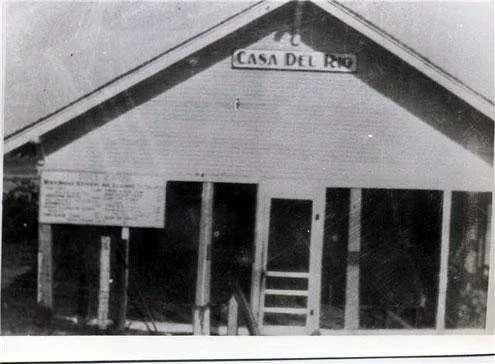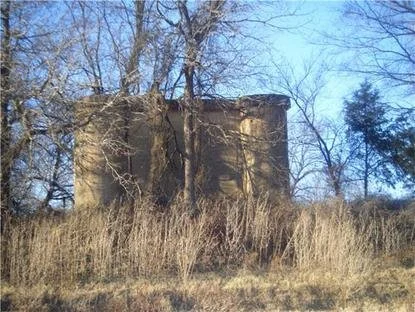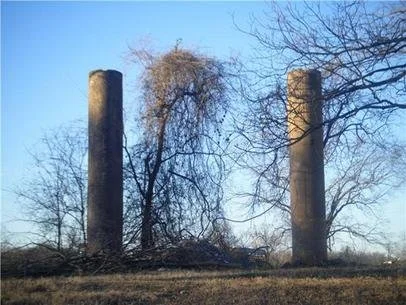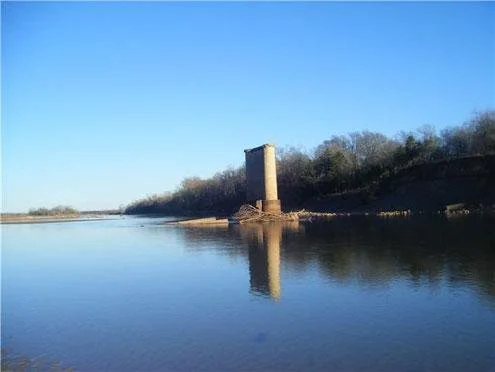The Bridges Across Red River
By Tim Davis. Reprinted from the North Texas e-News, July 22, 2015
In light of the recent weather, it is time to look back at another period when heavy rains wreaked havoc in this area. Softened soil caused suspension bridges to collapse, and flooding caused Red River to shift north of the current Sowell's Bluff bridge shortly after it was finished, thus rendering that structure utterly useless for roughly five years. It took much work and the completion of Denison Dam to calm the waters.
On the evening of March 4, 1920 a group of Bonham citizens met downtown at the Gem Café to discuss the need for a bridge spanning Red River, preferably at Sowell's Bluff. The next day's Bonham Daily Favorite noted that the affair was well attended, and actually referred to it as the "Red River Bridge Banquet."
Members of the group began lobbying local elected officials. Six years later it paid off.
The Bonham Daily Favorite of June 14, 1926 noted that the Fannin County Commissioners Court "gave a permit . . . to construct and maintain two bridges in this county across Red River."
The article went on to state that the Austin Bridge Company of Dallas was to form two corporations to oversee construction:
One of these corporations is to be known as the Bonham-Durant Bridge Company, and proposes to construct a bridge across the river at Sowell's Bluff. The other is to be the Bryan-Fannin Bridge Company and it would construct a bridge at Snows Ferry some twenty miles down the river from the first named bridge.
The bridge at Snow's Ferry was north of Telephone, and became known to locals as the Telephone Suspension Bridge.
Both structures would be toll bridges and would belong to the Austin Bridge Company.
A few months later the Daily Favorite of September 13 noted that the weather, as you would expect in Texas, was causing delays at Sowell's Bluff. "One of the large piers," it noted "is almost completed but the work is slow on account of the rains in the west causing the river to rise."
It further noted that a "large tractor used in hoisting material was almost completely submerged by a recent rise, and workers had to wait until the river fell to get it out."
On a related subject, county commissioners pledged to build and maintain good roads to the bridges. Bonham leaders began lobbying for a good state highway going from Bonham to Sowell's Bluff. Sounding an optimistic tone, the Daily Favoriteof September 13 stated that "the highway from Dallas to Sowell's Bluff, a distance of about 115 miles, coming through Leonard, Bailey and Bonham, will be put in excellent condition, and traffic to the bridges is expected to be heavy."
Construction was again delayed in the spring of 1927 due to heavy rains. The April 11 Dallas Morning News noted that one of the piers at Sowell's Bluff had been washed out and was "leaning up the river and is expected to topple at any moment." It further reported that the whole structure would have to be "done over again, as the pier will have to be blown out, a new foundation laid in the rock and another pier erected, which will take some time." In addition, both of the huge suspension cables, already in place, had to come down.
By late May 1927 the bridge at Telephone was open to traffic. The Bonham Daily Favorite of May 23 carried a big headline which read: "Telephone Bridge Has Been Opened - Public Crossed It." Once on the Oklahoma side, the road carried travelers to Bennington.
The Telephone Suspension Bridge from the Texas side. Photo courtesy of Bill Griffis
By July the Sowell's Bluff Bridge was ready for motorists. The Dallas Morning News of July 6 noted that the formal opening was a grand affair:
A parade across the bridge by Fannin County citizens met at the center of the bridge by the Oklahomans, who escorted them to the other side, where the christening exercises were held, a bottle of Red River water being broken on the bridge by Miss Isabel Moor, attended by her ladies in waiting from Bryan County, Oklahoma, and Fannin County, Texas. An address was delivered on the occasion by the Rev. W. H. Horton, pastor of the First Baptist Church of Bonham.
In addition, free barbecue was served and music was provided "throughout the day by the Bonham Municipal Band." Key speakers on the program were Cong. Sam Rayburn and Cong. Wilbur Cartwright of Oklahoma.
Not to be outdone, the folks at Telephone held a formal opening of their bridge roughly one month later. Similar to the Sowell's Bluff celebration, the August 11 Dallas Morning News noted that there was a christening with a bottle of Red River water followed by a picnic and music from the municipal bands of Bonham and Honey Grove.
The article further noted that in the midst of the festivities "the last of a number of old ferryboats that successively served interstate traffic at this point was to be seen half submerged in sand on the south bank of the river."
Now motorists on both sides of the Red were quite happy. Where there were no bridges, now there were two. The future seemed bright, but clouds were looming.
This image, photocopied from a postcard dated May 19, 1928, shows the two suspension bridges in Fannin County built by the Austin Bridge Co. of Dallas. The top one is the Telephone bridge, the bottom the Sowell's Bluff. Image courtesy of Bill Griffis.
By the early 1930s toll bridges were fast falling out of favor. Motorists, tired of the inconvenience and expense, began clamoring loudly for free bridges. Toll supporters and free supporters took sides, and sometimes things got a little ugly, as with the Red River Bridge War in Grayson County over the Denison-Durant bridges.
The toll house at the Telephone bridge, dubbed the Casa Del Rio. The reader board in the upper left hand corner listed the toll fees. Photo courtesy of Bill Griffis.
Joining the free bridge side, the Dallas Morning News of June 30, 1931 argued: "The toll bridge is an antiquated device that has no place in modern theories of interstate transport."
The whole argument ended up in federal courts, and ultimately it was ordered that some bridges would be free. Among them would be the Sowell's Bluff Bridge.
In late November 1932 the Bonham Daily Favorite reported almost daily on the fact that the Texas and Oklahoma highway commissions were close to sealing a deal to purchase the Sowell's Bluff span from the Austin Bridge Company in order to make it a free bridge. The November 30 issue carried a huge headline which read: "Red River Bridge be Free Soon, Appears."
Ladies on Sowell's Bluff suspension bridge - This photo (circa 1932) is shared by Jean Dodson, curator at the Fannin County Museum of History. The ladies on the Sowell's Bluff suspension bridge are Jean's mother, Ivon Copeland (pregnant with Jean at the time) and her sister, Euna Mae Nelson.
The Telephone bridge remained a toll structure owned by the Austin Bridge Company.
Roughly a year after Sowell's Bluff became free, the unthinkable happened. The Dallas Morning News of January 31, 1934 reported that the bridge had collapsed into the icy waters of Red River on the night of Monday, January 29. The collapse, according to the report, followed "the breaking of a cable on the Texas side." Fortunately, there was no traffic on the bridge at the time.
Elected officials on both sides of the river immediately began making plans for a replacement bridge. In addition to serving those wanting to visit across the state line, it would serve business purposes as well. For example, dairy farmers in southern Bryan County wanted it for hauling milk to the Kraft cheese factory in Bonham that opened in late 1934. The Daily Favorite of March 2, 1935 noted that "3,500 to 5,000 pounds of milk daily will be brought to the Bonham plant by dairy farmers in the Yuba school community."
One week later the Daily Favorite of March 9 carried a big front-page headline noting that Fannin County Judge S. F. Leslie had received a letter from the Texas Highway Commission (THC) announcing that it and the Oklahoma Highway Commission had agreed to share the costs of a new bridge at Sowell's Bluff.
By August of 1935 Judge Leslie received another letter from the THC noting that the plans for the new bridge were being drawn up. Moreover, the letter noted that federal dollars would be spent on the project by the United States Bureau of Public Roads.
The following summer the call went out for bids from contractors. The Bonham Daily Favorite of June 19, 1936 noted that the estimated cost of the new bridge was $350,000, and that $175,000 of that was being provided by the federal government. It further reported that Cong. Sam Rayburn had "no doubt that the plans for the bridge would receive immediate approval by the Federal Department of Good Roads."
Come fall the plans for the new bridge had been approved by the U. S. Bureau of Public Roads. The Daily Favorite of October 16 reported that the "length of the bridge will be 2,108.17 feet or a little over one-third of a mile." It also noted that the structure "will be concrete and steel."
The article further stated that "the structure would be approximately where the old bridge stood," but that "the north end in Bryan County will swing a considerable distance west of where the old structure connected with the north side of the river."
By late December it was reported that the bidding war had been won by the Kansas City Bridge Company, and that they might put their main offices in Bonham.
The January 19, 1937 Bonham Daily Favorite reported that S. McGlasson of the Texas and Pacific Railway Co., "advises the Favorite that a big shipment of the steel for Red River bridge has been ordered to be shipped from the east to Bonham to be used in the construction of the bridge."
Additionally, the T & P was "expecting some cranes and other machinery . . . which is to be used in handling the heavy material for the bridge."
By early 1937 it appeared that work on the new bridge would start soon. The Daily Favorite of January 25 reported that the Kansas City Bridge Company would have offices in Bonham. The January 29 issue noted that the "first carload of steel for the bridge has arrived in Bonham and is being unloaded today," and that "several additional carloads of steel were enroute to Bonham."
The article also hinted that the project might be at least a minor boost for local businesses when it noted that "2,500,000 pounds of cement" had been ordered from Bonham's own Higginbotham-Steger Lumber Company, located at 120 South Main Street. Moreover, men to work on the bridge had begun arriving in Bonham with an estimated "ten or more families" to move in later.
Another local boost came when it was announced that two local truck drivers, John R. Jaynes and Alonzo "Pood" Chaffin, had been contracted to move all materials and heavy equipment, including a huge concrete mixer, from the T & P rail yards to the Sowell's Bluff work site. The Daily Favorite of February 8 reported that "Jaynes and Chaffin have several trucks and are well prepared to do the work."
Before work on the new bridge could start, debris from the old one had to be cleared out. Most formidable of all were the concrete piers. It was decided in the planning stage that they could not be utilized in the new bridge, and so they were dynamited.
Once work did start, there were the predictable delays due to such things as material shortages, bad weather and, as you might expect, occasional flooding of the river.
By early 1938 it became apparent that the Texas approach to the bridge would have to be built up, thus requiring more money. The Dallas News of February 13 stated that the "State Highway Department has announced it has funds available with which to build the approach to the bridge over Red River at Sowell's Bluff," further noting that the "road will have to be built several feet higher in order to bring it to the bridge level which is higher than that of the bridge that fell in the river."
By April the structure had really taken form, and local folks were beginning to see what the finished product would look like. Photographs of it even appeared in the April 3 Dallas Morning News. The finishing work, however, went slow, no doubt too slow for those anxious to cross it for the first time.
By late summer and early fall, local folks were perhaps convinced that an opening date for the new bridge would never arrive. The Daily Favorite of August 17 reported that the bridge would be finished in early October. By early October it announced that the bridge should be ready for travel in early November.
By late November the Daily Favorite was telling that it would be open by early December. The November 23 issue also noted that Highway 78 from Bonham to the new bridge would more than likely be paved during the highway department's 1939-40 schedule.
Finally, the big day came. The Red River Bridge at Sowell's Bluff was opened to traffic on Saturday, December 10, 1938. Once again motorists in Fannin and Bryan counties enjoyed using two bridges, one free and one toll, to reach their destinations.
While the new bridge was opened for traffic in December, getting all officials together for a proper opening would take some time. Finally, on March 15, 1939 the bridge was opened with a formal ceremony. The Bonham High School band provided music, and elected officials from both states spoke to an estimated crowd of 1,000 people. Lunch was served later at the schoolhouse in Yuba.
SB II celebration - This photo is of a photo in a newspaper clipping, probably from the Bonham Herald, covering the formal opening of the second Sowell's Bluff bridge held on March 15, 1939. Photo by Tim Davis, clipping courtesy of the Bonham Public Library
As the new bridge was under construction, the Telephone bridge had seen an increase in traffic since the collapse of its Sowell's Bluff counterpart. For five years it was the lone workhorse for those crossing the river. Perhaps the additional strain had been too much.
Barely one year after the new bridge at Sowell's Bluff was opened, the unthinkable happened again. Just like its companion bridge before, the Telephone Suspension Bridge collapsed at roughly 11:15 on the morning of December 4, 1940. The headline in that day's Daily Favorite read: "Anchor Pulls Out of Ground on Texas Side Stream."
These photos show the Telephone Suspension Bridge after it collapsed on December 4, 1940. Photos courtesy of Bill Griffis.
While the collapse of the Telephone Bridge was a major inconvenience for folks in northeastern Fannin and southeastern Bryan counties, at least there was the new bridge at Sowell's Bluff. And it was an impressive and sturdy structure made with lots of steel and concrete. Surely it would be problem free, right?
Wrong! Only this time it wasn't the bridge - it was Mother Nature.
As often happens in north Texas and southern Oklahoma, spring rains were relatively heavy in 1941. And this led to considerable flooding on the river. By mid-June things were getting ugly at Sowell's Bluff. Red River was shifting its channel to the north and was threatening to go around the bridge.
For you fans of superstition, it became evident on Friday, June 13 that the swollen river was eating away inch by inch, foot by foot and yard by yard at the Oklahoma approach to the bridge. It was apparent to even the most casual observer that the river had come not to play, but to destroy. And it did so patiently, over a course of days.
The Sunday, June 15 Daily Favorite reported that the situation was worsening. The river's waters were only feet away from the top of the road and showed no signs of receding.
By the following Wednesday the paper reported that the washout was complete. The Oklahoma approach was gone, and the north end of the bridge was exposed. You might say that the Sowell's Bluff span had become a "bridge over troubled water." (My apologies to Simon & Garfunkel.)
This photo of a newspaper photo shows the north end of the current Sowell's Bluff bridge exposed after the Oklahoma approach washed out in June 1941. The clipping is from the October 21, 1993 Denison Herald. Photo and clipping courtesy of David Hix.
To those who had participated in, or who had watched closely, the building of the bridge, all of this was undoubtedly no surprise. During the construction phase the river had shown signs of wanting to shift its channel. The April 3, 1938 Dallas Morning News ran a short article, along with a photo, noting that the river wanted to go north. Sounding the same alarm roughly six weeks later, the May 17 issue stated that the "river several weeks ago cut north and threatened to by-pass the new bridge entirely."
The warnings of a few years earlier were of no help in mid-1941. You might say they were just water under the bridge.
All of a sudden the citizens of Fannin and Bryan counties were back to pre-1927 days with no bridge connecting them. Making matters worse was the announcement by officials that materials needed to make repairs were going to the war effort. It appeared that the bridge would be closed for quite some time, perhaps years.
A month after the washout an old-fashioned form of transportation across the Red made a return. The Bonham Daily Favorite of July 11 stated that Doc Jackson, of Willis, Oklahoma, and a Mr. Cowan would operate a ferry just west of the bridge. Jackson was running two ferries north of Whitesboro, and had promised to move one of them to Sowell's Bluff. County officials on both sides of the river promised to grade roads to the ferry.
By late summer the Dallas Morning News reported that Fannin County Judge O. L. Couch was assured that the Oklahoma approach to the bridge would be restored. The September 14 issue reported that Couch had "conferred with Speaker of the House Sam Rayburn, who said he would do all in his power to have the bridge put in commission again."
Although all agreed that the approach to the bridge would be rebuilt, it wasn't going to happen overnight. All concerned were urged to be patient. The general attitude was: We'll cross that bridge when we get to it.
As noted earlier, World War II took priority when it came to materials. Secondly, it made little sense to rebuild the approach unless flooding was brought under control. Fortunately, that issue was being addressed at the time by the construction of Denison Dam. Since flood control was one of the arguments for building the dam, it seemed logical to finish that project first.
Aside from more assurances that the problem would be fixed when circumstances allowed, 1942 brought little change. 1943 wasn't looking much better when good news finally arrived late that fall. The November 7 Dallas Morning News ran a short story noting that the Denison Dam was virtually completed and that the Oklahoma Highway Commission had "ordered $20,000 worth of work to restore the bridge across Red River" connecting Bonham to Durant. "Construction," it further reported, "of an earthen approach to the span will be feasible now that the Denison Dam will control the flow of water in the stream."
A little more than a year later the Bonham Daily Favorite of December 5 carried a front page story which noted that the Oklahoma Highway Commission was going to begin accepting bids on the restoration job in mid-January 1945.
The Daily Favorite of April 19, 1945 noted that while the bidding process was underway, officials had been told that steel sheet piling needed for building a sturdy retainer wall at the base of the new approach would not be available until October.
By early May the bids were opened, and the Daily Favorite of May 3 reported that the low bid of $268,021 came from the Amis Construction Company of Oklahoma City. The bid was approved by the highway commissions of both states.
By the following spring there was light at the end of the tunnel. The March 25 Bonham Daily Favorite reported that, "Bulldozers, draglines and every conceivable piece of digging machinery" had been used, and that "the river was flowing under the bridge again..."
Emphasizing the importance of flood control to the success of the whole project, a highway engineer was quoted as saying that "if it weren't for the Denison dam, the fill wouldn't hold a month."
On Friday, April 26, 1946 a formal ceremony was held for the re-opening of the Sowell's Bluff Bridge. The key speaker for the occasion was Bonham's own Speaker of the House, Mr. Sam.
And so, bridges rose, and bridges fell. And just when it seemed that the third time might indeed be the charm, the river threw everyone a curve, literally. Over time its flooding waters were reined in, the Oklahoma approach rebuilt, and millions of travelers since have crossed the triumphant bridge that once led to nowhere.
Many of the concrete pieces from the Telephone bridge are still in place today. This pier is on the Oklahoma side. Photo by Tim Davis
These concrete support columns are also on the Oklahoma side. Photo by Tim Davis
Huge concrete pier from the Telephone bridge. Note the concrete columns on the bluff on the Texas side in the background. One is still upright, while the other lies on the river bed. Photo by Tim Davis
Another look at the Telephone pier with the river that Spanish explorers centuries ago dubbed the Rio Rojo flowing around it. In his book The Red River in Southwestern History, historian Carl Newton Tyson noted: "Cold-hearted indeed is the individual who can gaze at a mighty river winding across the earth without feeling twinges of wanderlust." Photo by Tim Davis
Thanks to: the good folks at Two Rivers Organic Ranch (Bennington, OK), Dr. Mark Hoyle, Chad and Chase Andrews for allowing me access to the concrete ruins of the old Telephone Suspension Bridge; Craig Hilliard for allowing access in the Sowell's Bluff area; the ladies at the Bonham Public Library for their patience; Mr. David Hix, Mr. Bill Griffis and Mrs. Jean Dodson for sharing photos.














